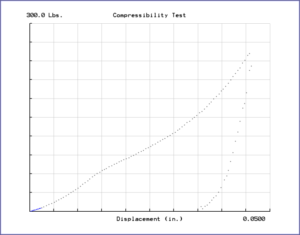 Here is the first installment of our “Why Do I Care” series. Every so often, we’ll blog about some of the questions people new to the gasket industry may be looking for more information on.
Here is the first installment of our “Why Do I Care” series. Every so often, we’ll blog about some of the questions people new to the gasket industry may be looking for more information on.
This week, we’re going to talk about compressibility and recovery. These are two of the most important properties in selecting a gasket material, and ones you definitely need to pay attention to. Having a material with the right compressibility and recovery for your application makes all the difference in the performance of the application.
Compressibility
How hard or soft is the material? How much will the material compress when pressure is applied to it? This is a key factor involved in the joint. What are the flanges like, and how much load is available? Are they cast or stamped, rigid or not? “Soft” sealing materials such as cork, rubber, sponge, foam, etc., compress large amounts and can be used when low flange load is present. Denser materials such as fibers, hard rubbers, composites, metals, and others require more load to achieve a seal and only compress a small amount. Gasket materials chosen should possess sufficient compressibility to overcome flange imperfections, internal pressure from fluid being sealed, and deflection.
Recovery
How springy is the material? How close to “normal” will the material be when pressure is removed? Recovery is what it’s all about in flat gasket applications. Materials must have sufficient recovery to maintain a seal after initial cycles and relaxation. Stiffer, denser products, while having less compressiblity, often have the best recovery characteristics. The magnitude of the deflection and recovery is less, but better.
 Look At The Data
Look At The Data
This is an example of compressibility charted against load. As you can see by this simple chart, the higher load creates more displacement. For many materials, they are nearly linear within their usable ranges, for “non-soft” materials such as fibers and composites, this would be up to 5000 psi. Engineers designing joints can benefit by this information to compare to the load available in the joint by the bolts (both #, type, and pattern) to assure adequate compression.
This chart is actually a load/deflection curve, which shows the full scope of both compressibility and recovery in a graphic form.
Now That You Know
You may be wondering why someone just can’t design a material that is “perfect” for compressibility and recovery? Well, that could be done, but what properties are you willing to give up? With any material, you need to find the balance you need between all properties, and that sometimes means giving a little of this for that. Doing your research and fully understanding what each gasket material has to offer is going to help ensure your application runs as smoothly as possible.
What are some other properties that you pay particular attention to? If you are interested in subscribing to Sealed-In’s blog posts, email sales@mtigasket.com.

Here is the first installment of our “Why Do I Care” series. Every so often, we’ll blog about some of the questions people new to the gasket industry may be looking for more information on.
This week, we’re going to talk about compressibility and recovery. These are two of the most important properties in selecting a gasket material, and ones you definitely need to pay attention to. Having a material with the right compressibility and recovery for your application makes all the difference in the performance of the application.
Compressibility
How hard or soft is the material? How much will the material compress when pressure is applied to it? This is a key factor involved in the joint. What are the flanges like, and how much load is available? Are they cast or stamped, rigid or not? “Soft” sealing materials such as cork, rubber, sponge, foam, etc., compress large amounts and can be used when low flange load is present. Denser materials such as fibers, hard rubbers, composites, metals, and others require more load to achieve a seal and only compress a small amount. Gasket materials chosen should possess sufficient compressibility to overcome flange imperfections, internal pressure from fluid being sealed, and deflection.
Recovery
How springy is the material? How close to “normal” will the material be when pressure is removed? Recovery is what it’s all about in flat gasket applications. Materials must have sufficient recovery to maintain a seal after initial cycles and relaxation. Stiffer, denser products, while having less compressiblity, often have the best recovery characteristics. The magnitude of the deflection and recovery is less, but better.
Look At The Data
This is an example of compressibility charted against load. As you can see by this simple chart, the higher load creates more displacement. For many materials, they are nearly linear within their usable ranges, for “non-soft” materials such as fibers and composites, this would be up to 5000 psi. Engineers designing joints can benefit by this information to compare to the load available in the joint by the bolts (both #, type, and pattern) to assure adequate compression.
This chart is actually a load/deflection curve, which shows the full scope of both compressibility and recovery in a graphic form.
Now That You Know
You may be wondering why someone just can’t design a material that is “perfect” for compressibility and recovery? Well, that could be done, but what properties are you willing to give up? With any material, you need to find the balance you need between all properties, and that sometimes means giving a little of this for that. Doing your research and fully understanding what each gasket material has to offer is going to help ensure your application runs as smoothly as possible.
What are some other properties that you pay particular attention to? If you are interested in subscribing to Sealed-In’s blog posts, email sales@mtigasket.com.

Here is the first installment of our “Why Do I Care” series. Every so often, we’ll blog about some of the questions people new to the gasket industry may be looking for more information on.
This week, we’re going to talk about compressibility and recovery. These are two of the most important properties in selecting a gasket material, and ones you definitely need to pay attention to. Having a material with the right compressibility and recovery for your application makes all the difference in the performance of the application.
Compressibility
How hard or soft is the material? How much will the material compress when pressure is applied to it? This is a key factor involved in the joint. What are the flanges like, and how much load is available? Are they cast or stamped, rigid or not? “Soft” sealing materials such as cork, rubber, sponge, foam, etc., compress large amounts and can be used when low flange load is present. Denser materials such as fibers, hard rubbers, composites, metals, and others require more load to achieve a seal and only compress a small amount. Gasket materials chosen should possess sufficient compressibility to overcome flange imperfections, internal pressure from fluid being sealed, and deflection.
Recovery
How springy is the material? How close to “normal” will the material be when pressure is removed? Recovery is what it’s all about in flat gasket applications. Materials must have sufficient recovery to maintain a seal after initial cycles and relaxation. Stiffer, denser products, while having less compressiblity, often have the best recovery characteristics. The magnitude of the deflection and recovery is less, but better.
Look At The Data
This is an example of compressibility charted against load. As you can see by this simple chart, the higher load creates more displacement. For many materials, they are nearly linear within their usable ranges, for “non-soft” materials such as fibers and composites, this would be up to 5000 psi. Engineers designing joints can benefit by this information to compare to the load available in the joint by the bolts (both #, type, and pattern) to assure adequate compression.
This chart is actually a load/deflection curve, which shows the full scope of both compressibility and recovery in a graphic form.
Now That You Know
You may be wondering why someone just can’t design a material that is “perfect” for compressibility and recovery? Well, that could be done, but what properties are you willing to give up? With any material, you need to find the balance you need between all properties, and that sometimes means giving a little of this for that. Doing your research and fully understanding what each gasket material has to offer is going to help ensure your application runs as smoothly as possible.
What are some other properties that you pay particular attention to? If you are interested in subscribing to Sealed-In’s blog posts, email sales@mtigasket.com.
